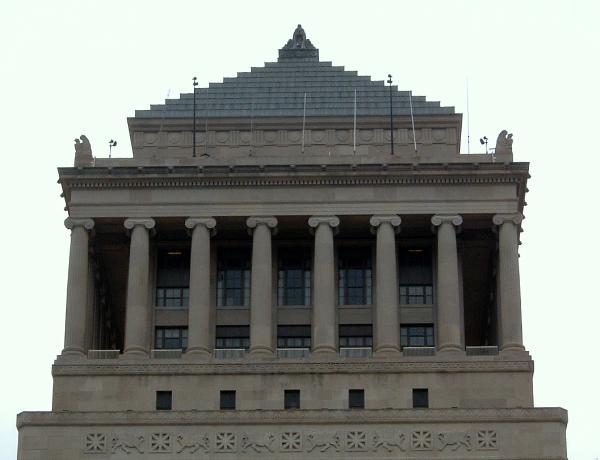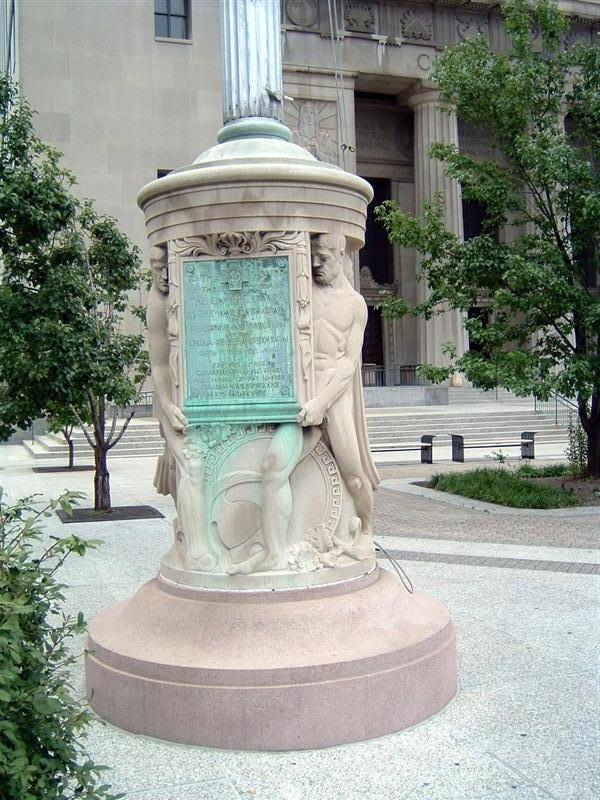 The
following is an excerpt from Missouri: A Guide to the 'Show Me' State,
1941 in the St Louis section:
The
following is an excerpt from Missouri: A Guide to the 'Show Me' State,
1941 in the St Louis section:
The Civil Courts Building, Eleventh St. to Twelfth St. Blvd. , and Market
to Chestnut Sts, faces the plaza's eastern extension. A 14-story, 385-foot
structure of Indiana limestone, it is the city's most controversial
architectural medley. The building rises in modern office-building
style to a setback at the 245-foot level (twelve floor) level. There it is
augmented by Ionic Greek temple, surmounted, in turn, by an Egyptian pyramid
roof with two aluminum griffins at its crest. The architectural
peculiarities are partly the result of an effort by city officials to afford a
higher accessible point than that reached by the near-by Southwestern Bell
Telephone Company Building. Completed in June, 1930, at a cost of
$4,520,000, the building houses the Civil, Circuit, Probate, and Appeals
Courts other public offices. An observation promenade surrounds the
twelfth floor. At Chestnut Street, on the Twelfth St. Boulevard side, a
memorial flagpole with a sculptured stone base, the work of Victor S. Holm,
commemorates veterans of the Spanish-American War, Philippine Insurrection, and
China Relief Expedition.
 From
the 22nd Judicial Circuit Court of Missouri website:
From
the 22nd Judicial Circuit Court of Missouri website:
On February 9, 1923, the residents of the City of St. Louis voted a bond
issue in the amount of $87 million for extensive city improvements, including
the construction of the Civil Courts Building. The cornerstone of the new
courthouse was laid February 3, 1928, and the building was dedicated and
occupied on June 21, 1930. (Cost - $4,520,000). The architectural staff of the
City of St. Louis Plaza Commission designed it.
Rising 255 feet above ground level, the building assumes the noble design
of a Greek temple, a replica of the tomb of Mausolus at Halicarnassus, one of
the Seven Wonders of the Ancient World. A massive colonnade of 32 Ionic columns
surrounds the building, eight on each side. Each column, which is made up of a
base, 6 fluted drums, and a cap, is about 42 feet high, 5 1/2 feet in diameter,
and weighs about 65 tons.
The material in the columns, as well as the facing for the exterior of the
entire building, comprise more than 15,000 pieces of limestone, quarried and
milled at Bedford, Indiana. An eagle is perched at each of the four corners of
the building above the colonnade. A frieze of griffins encircles the building
below the colonnade.
The pyramidal-shaped roof of the building is made of cast aluminum. At the
summit, there are two Greek sphinx-like figures, one facing east, and the other
facing west. Each has the body of a lion, the wings of an eagle, and the face of
a woman, with the fleur-de-lis of St. Louis adorned on the chest. Each measures
20 feet long, 12 feet wide and 12 feet tall. They too are made of aluminum
which, together with the aluminum of the pyramidal roof, were connected with the
steel framework of the building, serving as a lightning conductor. The two
sphinx-like forms, towering 380 feet above the sidewalk, are hollow, the
interior of each resembling a room of ordinary size, to which access is gained
through an opening at the base.
Except for some of the ornamentation, the design of the Civil Courts
Building carefully follows the original design of the ancient tomb; however, at
the top, the sphinx-like figures were substituted for the sculpture of a 4-horse
chariot driven by Mausolus and Artemisia.
The building remains the Civil Courts building serving the 22nd Judicial
Circuit Court of Missouri.